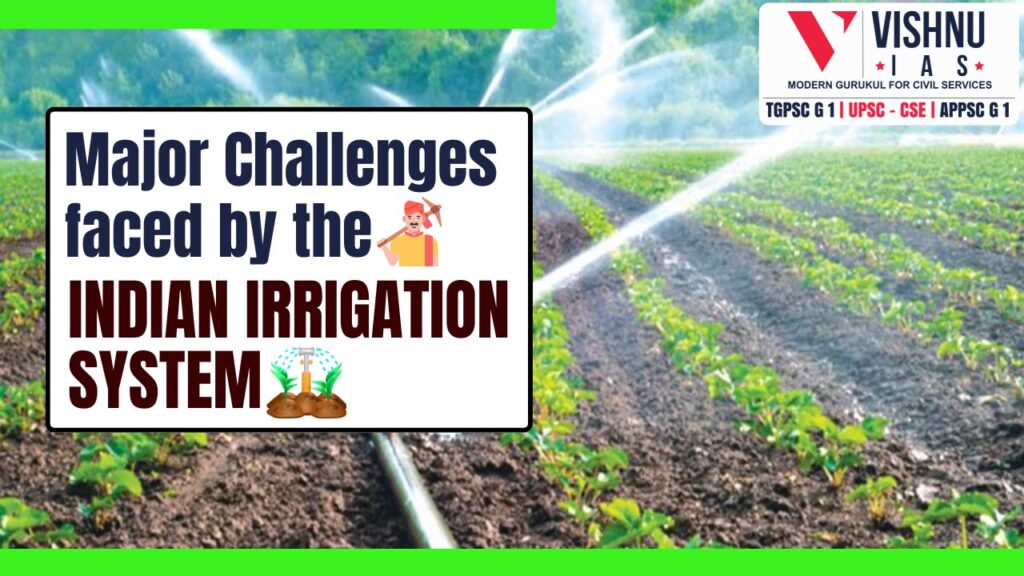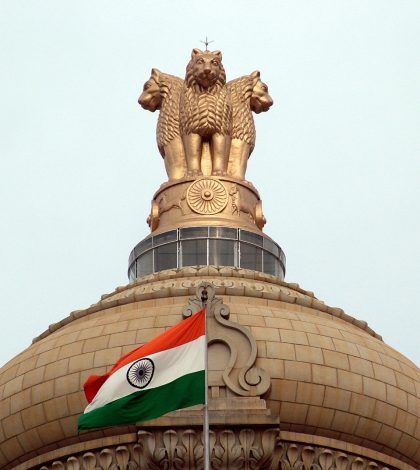Discuss the major challenges faced by the Indian irrigation system in recent times. How can irrigation efficiency and sustainability be improved to address these challenges?
Introduction:
Irrigation plays a vital role in India’s agricultural industry, utilizing approximately 80% of the nation’s water supply. Although India is the largest consumer of agricultural water worldwide, it encounters considerable obstacles in achieving fair and sustainable irrigation practices. The reliance on unpredictable monsoon seasons, declining infrastructure, depletion of groundwater resources, and ineffective water management strategies intensify the existing crisis.
Major Challenges Faced by the Indian Irrigation System:
Water Scarcity and Inequitable Distribution:
- Despite significant water consumption, the distribution of irrigation water is still inequitable, largely due to social disparities and governance structures. Underprivileged communities, particularly women and smallholder farmers, frequently experience a lack of access to adequate water resources.
Unsustainable Expansion of Irrigation:
- Crops that require significant water, such as rice, wheat, and sugarcane, are cultivated in areas with limited water resources, worsening the existing shortages.
- From 2000 to 2015, India represented 36% of the worldwide increase in unsustainable irrigation practices, resulting in detrimental environmental and socio-economic effects.
Over-Extraction of Groundwater:
- Groundwater serves as the primary source for irrigation; however, its over-extraction has resulted in significant depletion.
- Approximately 17% of groundwater assessment units in India are categorized as ‘over-exploited,’ with an additional 3.9% classified as being in a ‘critical’ condition.
High Energy Consumption and Carbon Emissions:
- The extensive extraction of groundwater leads to significant energy usage, which in turn results in high levels of carbon emissions.
- Furthermore, groundwater irrigation is responsible for approximately 8-11% of the overall carbon emissions in India.
Low Irrigation Efficiency and Productivity:
- India’s irrigation systems exhibit an operational efficiency of merely 38%, in contrast to the 55% observed in developed nations.
- Ineffective water utilization practices and inappropriate cropping patterns have resulted in diminished irrigation water productivity (IWP).
- For instance, Punjab, which boasts the highest land productivity for rice, simultaneously reports one of the lowest IWPs for this crop.
Environmental Externalities:
- The persistent inundation of paddy fields plays a substantial role in the emissions associated with global agricultural land, while inadequate water management strategies result in greenhouse gas emissions and various detrimental effects on the environment.
Dependence on Unpredictable Monsoon Patterns:
- The irrigation system in India relies significantly on the monsoon season, which is characterized by its unpredictability and frequent delays.
- Areas such as Marathwada and Vidarbha in Maharashtra experience recurrent drought conditions, resulting in agricultural failures and heightened distress among farmers.
Deterioration of Irrigation Infrastructure:
- Numerous irrigation systems have been in operation for several decades and suffer from inadequate maintenance, resulting in significant inefficiencies and excessive water loss.
- Additionally, the presence of silt in dams and canals, along with leaks in distribution networks, further diminishes water accessibility for agricultural purposes.
Fragmented Policy Implementation:
- India’s irrigation policies exhibit fragmentation across various governmental tiers, resulting in inadequate coordination and inefficiency.
- The absence of a cohesive approach to water resource management exacerbates the challenges associated with the execution of irrigation initiatives.
Improving Irrigation Efficiency and Sustainability:
To address these challenges, India must adopt a multi-pronged approach focusing on efficiency, sustainability, and equitable distribution. Some key strategies include:
Adopting Water-Saving Technologies:
- The adoption of micro-irrigation systems, including drip irrigation, is essential for reducing water wastage, particularly in crops that require significant water, such as sugarcane.
- Additionally, encouraging the use of alternate wetting and drying methods in rice farming can lead to decreased water consumption and lower emissions.
Enhancing Irrigation Efficiency:
- Enhancing the efficiency of irrigation systems in terms of conveyance and application to minimize water loss, while promoting rainwater harvesting and the use of tailwater storage pits as additional sources for irrigation.
Regulating Groundwater Usage:
- Establishing regulations for groundwater usage via policy measures to avert excessive extraction, while also providing economic incentives for the efficient use of water, including guaranteed grid access for solar-powered irrigation systems.
Promoting Sustainable Cropping Patterns:
- Promoting the transition of farmers towards cultivating crops that require less water in areas facing water scarcity, while also aligning agricultural practices with the local water resources to enhance irrigation effectiveness.
Participatory Water Management:
- Implementing demand-responsive allocation frameworks managed by participatory irrigation management entities to guarantee fair distribution, while enhancing water governance systems to rectify inequalities in access and resource allocation.
Government Initiatives for Efficient Irrigation Management:
- The Pradhan Mantri Krishi Sinchayee Yojana (PMKSY), initiated in 2015, seeks to ensure that every agricultural field has access to water by enhancing irrigation infrastructure, advocating for micro-irrigation, and promoting the efficient utilization of water resources.
- Additionally, the Command Area Development and Water Management initiative aims to optimize irrigation capabilities through improved management strategies within designated command areas.
- The National Water Policy of 2012 underscores the importance of sustainable water management practices, aiming to minimize water wastage and encourage the implementation of water-conserving technologies.
- Furthermore, Participatory Irrigation Management (PIM) fosters the establishment of Water User Associations, which are tasked with overseeing canal systems to facilitate more equitable water distribution.
- Lastly, India has engaged in international collaborations with countries such as Israel and Australia to incorporate advanced irrigation methodologies, including drip irrigation and precision farming.
Conclusion:
India’s irrigation system is at a crossroads, facing severe challenges due to water scarcity, inefficient practices, and environmental degradation. However, with the right mix of technology, policy reforms, and participatory governance, irrigation efficiency and sustainability can be significantly improved. By adopting water-saving technologies, regulating groundwater usage, promoting sustainable cropping patterns, and strengthening governance mechanisms, India can ensure equitable water distribution and long-term agricultural sustainability.


